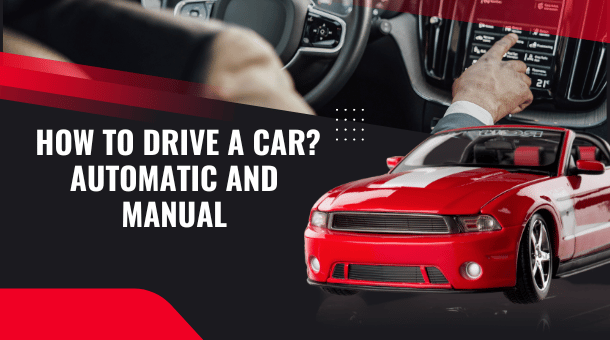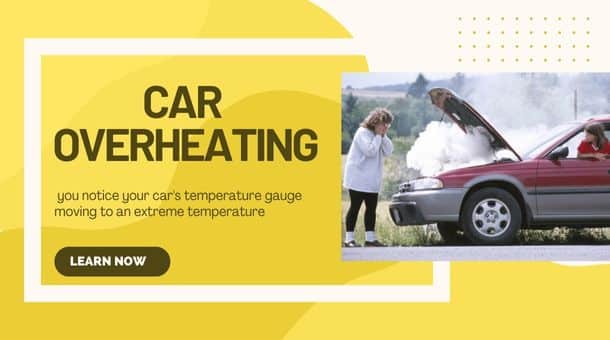In this article we will discussed about how to Drive a Car? Automatic and Manual Car Driving Tips! Are you ready to change gears and drive with a manually-driven vehicle? Whether you’re a novice driver or have already driven numerous miles.
It may require some adjustment to the learning process to control the stick. Here are four suggestions that will assist you in the shift from driving using an auto transmission to the manual one simpler.
How to Drive a Car? Automatic and Manual?
Whatever car you drive, the basic rules of driving are the same. The pedals and gear levers, the handbrake, the steering wheel, and so on are not changed dramatically from one vehicle to the next. This is a step-by-step instruction for driving a manual transmission vehicle if you’re thinking about how to learn the art of driving a car.
Step 1. Hop in the seat of your driver. Lock all the doors, and wear the seat belt.
Step 2. Ensure the car is operating in neutral and then release the handbrake.
Step 3. Use the brake (pedal to the middle) with your right foot, and start the Engine.
Step 4. Use your clutch (leftmost pedal) by using your left foot. Then shift into the 1st gear.
Step 5. Next, gradually release the clutch until the car starts moving forward.
Step 6. Make use of the right side of your foot to push an accelerator pedal to boost the car’s RPM.
Step 7. Let the clutch pedal go completely and utilize your accelerator pedal to boost the speed.
Step 8 Once you’re in motion, utilize the brake, accelerator, and clutch pedal according to the requirements.
How to Drive an Automatic Car?
Many car drivers in India that have been driving manual transmission-equipped cars all their lives wonder how to drive an automatic car. Autos are usually simpler to drive because they don’t need to pull the clutch.
- When you are ready to drive an auto, make sure the gear lever’s position is N (Neutral)
- Then, press the brake pedal then switch on the ignition.
- Place the gear lever in mode D (Drive) mode, and then start by releasing the brake pedal.
- When the car begins moving ahead, use your left foot to push the brake and accelerator to limit the speed.
- The left foot must be in a position of rest at all times and should not be used to apply brakes.
- When parking, ensure that you keep the car in the P-position and use the handbrake to keep the car from rolling forward or backward while parked on the slope.
How to Drive a Manual Car?
In India, most new drivers start with a manual car; hence, most Indian car driving license holders are well versed in driving a manual transmission-equipped light motor vehicle. But, if you’ve used an automatic car and are now planning to shift to a stick shift, Here’s how to switch the gears in a car with a manual transmission.
- A manual car includes three pedals, three of them for brake, accelerator, and clutch.
- The left leg controls the accelerator and brake pedals, whereas the right leg functions as the accelerator. The brake pedal’s purpose is used to slow the car down. It’s important to remember that the more firm you press on the pedal, the more quickly it’ll reduce your speed. The accelerator can increase the Engine’s performance, which, it turns out, speeds up your car.
- The clutch pedal can make the driving of a manual vehicle difficult. Without getting into the specifics, the clutch pedal can be utilized to assist you in shifting gears.
- To shift gears, completely engage the clutch pedal while taking off the accelerator pedal.
- Put the gear into the one you wish to drive, then slowly start taking off your clutch.
- As you slowly compress the clutch pedal, you will begin pressing on the accelerator pedal.
- Gradually release the clutch pedal fully, and use your accelerator pedal to regulate the car’s speed.
- It is important to keep in mind that taking your foot off the brake pedal or pressing it too hard when you release the clutch can cause the Engine to stop and stall your vehicle.
This is how to change the gears of your car that has a manual transmission.
How to control car steering?
The steering wheel control in manual cars can be challenging since you’ll constantly be changing gears with hands that are left. With time you’ll find it easier to operate the steering wheel of a manual car. Here are some suggestions to steer the wheel in a vehicle with a manual transmission.
The wheel’s direction (if there’s an alternative) is to your requirements. It shouldn’t be placed too near or out of your reach.
Keep the wheel at 10 o’clock or 2 clock position.
Make sure to place your right hand on the steering wheel while shifting gears using your left.
Make sure that your inputs ensure that your inputs are smooth. Don’t suddenly steer or turn between left and right or vice versa unless necessary.
Do not take your hands off the steering wheel when moving.
How to control the clutch and accelerator?
The clutch is a crucial component in a manual car because it aids in smoothly shifting gears. This is why one must be cautious when using the Grip and accelerator. Always utilize your left hand to control the clutch and the right foot for the accelerator. Here are a few suggestions to manage the accelerator and clutch effectively in a manual vehicle.
- Release the accelerator, then press the clutch entirely before changing gears.
- Release the clutch slowly when you have selected the desired gear, and then press the accelerator simultaneously to ensure that the vehicle does not stall.
- Don’t make use of the clutch to control the vehicle’s speed. It could harm parts of the Grip.
- Don’t shift gears if the clutch isn’t fully completely. It could cause significant harm to your gearbox.
- Make use of the accelerator pedal with care and increase speed gradually.
- Avoid sudden accelerations as they can cause an out-of-control situation or cause fuel consumption to decrease.
How do I reverse it?
Reversing a manual vehicle is similar to changing an AMT or automatic car. The only difference lies in the clutch pedal. When performing a reverse move, it is important to be aware of the clutch and accelerator pedal. These are the steps you need to follow to reverse a manual vehicle.
- Use the clutch pedal to engage the brake, and shift to the reverse gear.
- Release the clutch slowly and slowly push the accelerator pedal.
- Be careful when using the accelerator since you don’t need too much acceleration to reverse.
- The steering wheel should be turned with care since reverse driving has a reverse steering effect.
- Move the steering wheel to the left to reverse to reverse to the right and in reverse.
- To stop the car, you must use the clutch pedal to use the brakes.
Mistakes to avoid while driving a manual car
Here are some mistakes you should avoid when driving a car with a manual transmission.
Don’t drive a car with a manual transmission without understanding the pattern of gear shifts. You could end up choosing the wrong gear driving.
- Make sure you select the correct gear. The wrong gear could cause the car to stop or Damage the gearbox.
- Do not change gears without activating the clutch.
- Avoid using the clutch too much to limit the speed of your vehicle.
- Use your left foot for brakes. Be sure to make use of your right foot to accelerate and brake.
- Don’t let your hands slip off the steering wheel when shifting gears. Be sure not to become distracted while shifting gears. Make sure you are focused on the road while you drive.
Tips to drive a new car for beginners
Driving can be daunting if you’ve just learned to drive and bought the latest car that is crowded. However, over time, you’ll become familiar with the car and learn the necessary skills to operate the vehicle. Here are some new tips for driving in the car that will aid you in learning how to use a car for novices.
Finding the right seat position and place of seating is important for drivers as it affects the vehicle’s visibility and allows access to different vehicle controls. Find a position that is suitable for you.
You can experiment using seat adjustments to find the ideal place. Adjust your seat in that your back and thighs aren’t stretched. While doing this, you should be able to easily reach the steering wheel, pedals, and other controls.
Make yourself familiar with the controls, such as adjusting mirrors and switches: Acquaint yourself with the car before taking the car for a spin. Learn all rules and features and the function of the various buttons and knobs inside the interior.
Please make yourself comfortable with the pedals and ensure that you can operate them effectively. Be familiar with the gear lever, and be aware of the shift pattern.
Then, you can adjust for the ORVMs (Outside Rear View Mirrors) and IRVM (Inside Rear View Mirror). Make sure you have an excellent perspective of what’s happening behind.
Keep the wheel in the correct position correctly: As a beginner driver, you might forget this crucial point. However, keeping the wheel correctly is vital.
Be sure to stick to the 10 o’clock O’clock position. Use the steering wheel using both hands unless you change gears. Make sure you are smooth and gentle when using your steering wheel input.
Don’t put your hand on the gear lever. It is among the most common mistakes beginners make when driving in a manual vehicle. Please don’t place your hands on the gear lever because it transfers weight to the lever, which causes the destruction of the internal parts in the gearbox. Additionally, driving while one hand is in the direction of the vehicle is not recommended.
Take a drive in the morning and during good weather conditions: As new drivers attempt to drive in the daytime. It is vital to be visible, particularly for those with limited experience in driving, and driving after sunset can result in problems due to low visibility. Avoid driving during poor weather conditions. For instance, don’t take your car out in the event of thunderstorms.
Take a drive when you’re healthy and in a good attitude: It’s one of those aspects that you often avoid. Driving in a stressed State or when stressed can cause serious harm. Make sure you be sure to go with a clear head to be able to focus on driving along the highway ahead. Don’t drive when you’re stressed or tired.
Beware of driving on highwaysInitially after you are comfortable driving your new vehicle, keep to the roads you are comfortable with. Avoid driving on highways since automobiles travel at high speeds with multiple lanes. Even a minor mistake could be costly. Therefore, it is better to travel on roads that have slow-moving traffic.
Do not be anxious:
- Be in a relaxed State while driving.
- Concentrate your attention on the roadway ahead and your car’s controls.
- Don’t panic in the event of small hiccups in your driving. This will only cause the problem to get worse.
- Be calm and focus on the corrective steps you have to adopt.
Speed up: Never drive at high speeds, as you might lose control of your vehicle. If you have no experience driving, it is possible that you are not ready to take any corrective steps if your control is lost in your car. Additionally, you must be aware of the speed limits established by law. It is important to be aware when crossing curves and bends. Take turns at slower speeds to ensure that you are on the safe side.
Take all documents related to your relevant documents for your driver and vehicle:
Lastly, carry all related documents to your vehicle when you take your vehicle for a drive. Authorities could inspect your car, and if you fail to provide the necessary documents can result in fines.
Therefore, you must always have important documents like the Driving Licence and Registration Certificate, Car Insurance Certificate, and PUC (Pollution Under Control) Certificate.
Can I drive a manual with an automatic license?
- No. If you’ve got an automatic driver’s license, you can only drive with an automatic.
- Although it limits the number of vehicles that you can use, certain people prefer to learn and be able to pass their test on auto mode, as it eliminates a lot of the elements of learning how to drive that people have difficulty with, such as controlling the clutch and using the gears.
- If you are a driver with a manual license and you have a manual license, you can drive both manuals and autos.
- For more information about learning to drive, please visit our section on learning to drive.
- After you’ve passed the exam, make sure you buy the RAC breakdown insurance to ensure you’re protected in the event your vehicle fails to start.
Frequently asked questions
Here are some of the most frequently asked questions about driving in a vehicle.
How much time does it take to learn car driving?
It’s all about the pace of learning. Generally, a novice can take about a week to master driving a car. But, it could take longer to master the skills as it requires more time.
Is it easy to drive my car in the USA?
What is easy and challenging is contingent on your abilities and experience in driving. In general, driving a car can be more difficult in cities since it requires most concentration when driving. It can be difficult to operate a car when driving on Indian roads.
How do I stop a manual car?
To bring a manual vehicle to a standstill, the driver must release the accelerator and step onto the brake pedal using your left foot. If the car slows substantially, you can use the clutch using your left foot and continue to press the brake pedal till you are at an impasse and then shift your gearbox back into neutral.
How do I use the handbrake in my automatic car?
You can use the “P’ (Park) mode and handbrake when parking the automatic car. Additionally, the handbrake can be used as a backup in case the primary brakes are not working properly on the vehicle. Handbrakes can also be helpful if the automatic transmission fails and you can’t activate it in the Park mode.




